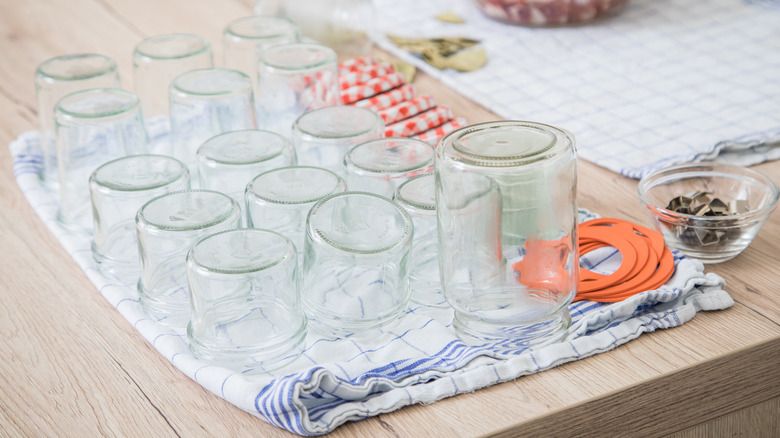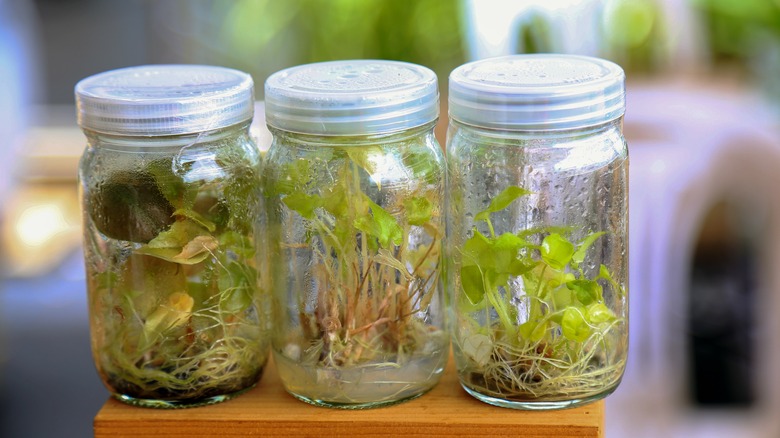The Clever Way Bookworms Should Be Reusing Old Glass Jars Around The House
We may receive a commission on purchases made from links.
As a bookworm, opening the temptingly crisp — or deliciously worn! — pages of a book is a sure way to transport yourself from your reality to another dimension altogether. Real book lovers know how much more fun it is to dive into a book in a place that inspires you to read. One clever way to create this vibe is to decorate your bookshelf with immersive, novelty bookends made of reused old glass jars. Since the jars are see-through, you can stick just about anything in them that will draw your attention and make you want to grab a book right off the shelf. From colorful marbles to miniature books, your magical jars of fantasy will speak to you and be useful in propping your books up at once.
Bookends are necessary if you have a bookcase or shelf and prefer to keep your tomes standing up vertically. They act as stops and even dividers to designate your books into particular sections. However, just because they serve a technical purpose doesn't mean you can't use them as décor to style your bookshelf. With glass jar bookends, you can spruce up your reading space with timeless craftsmanship that won't cost you a pretty penny but will brighten up your day whenever you see them.
Make DIY micro-mini books for your glass jar bookends
One of the useful things about the DIY glass jar bookends is that because these bookends are meant to inspire wonder, you can fill them with more than marbles. Since bookends are supposed to be structurally solid, you can add whatever heavy items inside them that you wish. For bookworms, this is a good time to bring out all those miniature book charms and fill one of your jars with them. If you don't have any, you can put them together in a flash using white polymer baking clay and Elmer's glue from Amazon, and then regular household tools like scissors, a blade, a paintbrush, and your baking tray.
Gather your kids for the arts and crafts project and print out mini versions of all your favorite book covers. Cut the prints out, fold them twice at the spine to shape them, and pile them up. Now, bring out a ball of polymer clay and flatten it into the thickness you want for the mini-book. Use a print-out book cover to measure the width and height and cut off the excess clay. Use it as a template to cut out more clay books. Place them on a baking tray and bake them according to the instructions on the label of the clay container. Once hardened, let them cool before gluing on the cover prints. Brush more glue onto the miniature books to laminate them and place them in the jars.
Build miniature terrariums out of the old glass jars
If you want bookends with a bit more life to them, then you can build your glass jar terrarium for your bookshelf. You don't even have to go purchase any ingredients when you can just scout for them in the yard. You can build an open terrarium or a closed one depending on the humidity requirement of the plant.
Start with a layer of pebbles at the bottom for a solid structure before adding another layer of charcoal for water and odor absorption. After this, you can add the soil, which will likely be the thickest layer, to give the plants enough space to take root and grow. Since the terrarium is in a shallow glass jar, you'll have to choose plants that don't have deep roots. Succulents are a great choice because they come in miniature versions, but you'll have to leave the glass jar open. For a closed terrarium, Fittonia makes a great plant child because it doesn't need direct sunlight and it loves moisture. Place your terrariums at the beginning and end of your books when you're done with them.
You can also encourage your kids to save by turning a couple of old glass jars into piggy bank bookends. Every time they finish a book, drop a silver dollar or some loose change into it. If nothing else, the sight of all that money will motivate them to pick up a book and get their reading on.

